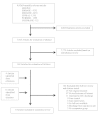A systematic review of tools for predicting severe adverse events following patient discharge from intensive care units
- PMID: 23718698
- PMCID: PMC4056089
- DOI: 10.1186/cc12747
A systematic review of tools for predicting severe adverse events following patient discharge from intensive care units
Abstract
Introduction: The discharge of patients from the intensive care unit (ICU) to a hospital ward is a common transition of care that is associated with error and adverse events. Risk stratification tools may help identify high-risk patients for targeted interventions, but it is unclear if proper tools have been developed.
Methods: We searched Ovid EMBASE, Ovid MEDLINE, CINAHL, PUBMED and Cochrane Central Register of Controlled Trials from the earliest available date through March 2013, plus reference lists and citations of all studies included in the systematic review. Cohort studies were selected that described the derivation, validation or clinical impact of tools for predicting medical emergency team activation, ICU readmission or mortality following patient discharge from the ICU. Data were extracted on the study design, setting, population, sample size, tool (components, measurement properties) and outcomes.
Results: The literature search identified 9,926 citations, of which eight studies describing eight tools met the inclusion criteria. Reported outcomes included ICU readmission (n=4 studies), hospital mortality (n=3 studies) and both ICU readmission and hospital mortality (n=1 studies). Seven of the tools were comprised of distinct measurable component variables, while one tool used subjective scoring of patient risk by intensive care physicians. The areas under receiver operator curves were reported for all studies and ranged from 0.66 to 0.92. A single study provided a direct comparative analysis between two tools. We did not find any studies evaluating the impact of risk prediction on processes and outcomes of care.
Conclusions: Eight risk stratification tools for predicting severe adverse events following patient discharge from ICU have been developed, but have undergone limited comparative evaluation. Although risk stratification tools may help clinician decision-making, further evaluation of the existing tools' effects on care is required prior to clinical implementation.
References
-
- Greenhalgh T. Narrative Research in Health and Illness. Oxford, UK: Blackwell Publishing Ltd, Malden, Massachusetts, USA; 2008. Meta-Narrative mapping: a new approach to the systematic review of complex evidence; pp. 349–381.
Publication types
MeSH terms
LinkOut - more resources
Full Text Sources
Other Literature Sources
Molecular Biology Databases
Miscellaneous


